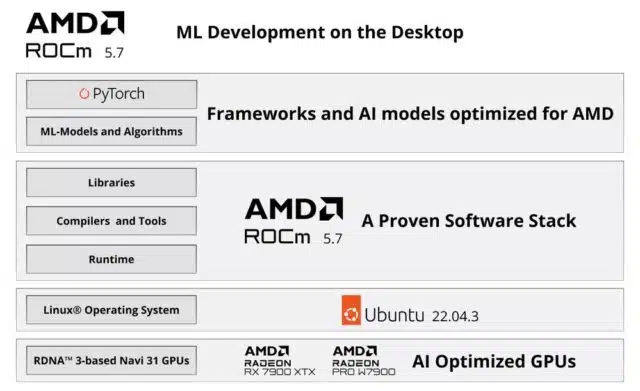

The landscape of Machine Learning (ML) is constantly evolving, and the tools that power this tech revolution are accelerating at an equal pace. AMD has recently unveiled its ROCm 5.7 platform on Ubuntu Linux, marking a significant stride towards empowering ML practitioners with robust resources.
This latest update is designed to harness the parallel computing prowess of the newly introduced Radeon RX 7900 XTX and Radeon PRO W7900 graphics cards, both of which are built on the advanced AMD RDNA 3 GPU architecture.
In an era where ML models are outgrowing the standard hardware and software capabilities, the quest for cost-effective, high-performance solutions is paramount. The integration of Radeon 7900 series GPUs in a local PC or workstation reveals a new realm of possibilities for ML engineers.
These GPUs, boasting colossal memory sizes of 24GB and 48GB, are not only capable but also affordable solutions to the burgeoning workflow challenges faced in ML development and training. The Radeon 7900 series GPUs, courtesy of the RDNA 3 GPU architecture, now come with a whopping 192 AI accelerators, delivering over 2x higher AI performance per Compute Unit (CU) compared to their predecessors.
The AMD ROCm, an acronym for Radeon Open Compute, is a comprehensive platform encapsulating a plethora of domains including general-purpose computing on GPUs (GPGPU), high performance computing (HPC), and heterogeneous computing. With the advent of the ROCm 5.7 software stack, developers utilizing PyTorch, one of the premier ML frameworks, can now tap into the vast parallel compute power of RDNA 3 architecture-based GPUs.This unified software stack isn’t just confined to desktops; it extends its support to the CDNA GPU architecture of the AMD Instinct MI series accelerators, bridging the gap between desktop and datacenter environments.
At the heart of the AMD ROCm platform lies the essence of Open-Source Software (OSS), providing a fertile ground for developers to tailor their GPU software as per their unique requirements. This not only fosters a collaborative environment among the developer community but also propels agile and rapid solution development. The underlying goal of the AMD ROCm platform is to enable users to fully leverage their GPU hardware investments, creating a secure, integrated, and open-source software ecosystem for a myriad of applications ranging from HPC, AI, scientific computing to CAD.
Dan Wood, AMD’s Vice President of Radeon Product Management explains, “We are excited to offer the AI community new support for machine learning development using PyTorch built on the AMD Radeon RX 7900 XTX and Radeon PRO W7900 GPUs and the ROCm open software platform. This is our first RDNA 3 architecture-based implementation, and we are looking forward to partnering with the community.”
As the tech industry marches towards a holistic ecosystem encompassing a diverse array of systems, frameworks, and accelerators, AMD is steadfast in its mission to make AI more accessible. By facilitating a local client-based setup for ML development with RDNA 3 architecture-based desktop GPUs, AMD is not only bolstering the AI community but also envisaging a wider support spectrum for additional ML frameworks and operating systems.
